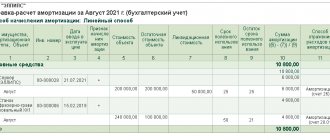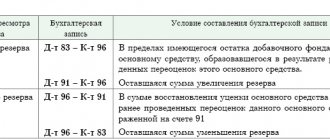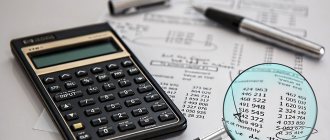Accounting for fixed assets at an enterprise in 2022 - 2022
First of all, accounting specialists at an enterprise should clearly understand the differences and similarities in approaches to reflecting fixed assets and transactions with them in the accounting and tax accounting of fixed assets.
In both accounting and tax accounting, in order for a company to consider certain equipment as its fixed asset, the object must meet the following criteria:
- the estimated period of use of the object exceeds 12 months;
- the object was acquired for use in the business of the enterprise, and not for resale;
- the asset is capable of bringing economic benefits to the enterprise;
- the initial cost exceeds 100,000 rubles. for tax accounting purposes and the amount approved by the enterprise from 2022 (clause 5 of FSBU 6/2020 “Fixed assets”) or 40,000 rubles. until the end of 2021 (clause 5 of PBU 6/01 “Accounting for fixed assets”).
Since 2022, PBU 6/01 “Accounting for fixed assets” has lost force, it was replaced by two new FSBU 6/2020 “Fixed assets” and FSBU 26/2020 “Capital investments”. ConsultantPlus experts explained in detail what the new standards have changed in asset accounting compared to PBU 6/01. Get trial access to the system for free and go to the Ready-made solution.
Until 01/01/2022, the criterion for the initial cost of fixed assets in accounting did not coincide with that in tax accounting: fixed assets were considered equipment worth more than 40,000 rubles. in accounting more than 100,000 rubles. in the tax office. But from 01/01/2022, FSBU 6/2020 came into force, according to which fixed assets began to be recognized for accounting purposes as property, the value of which is established by the enterprise independently. To avoid temporary differences between tax and accounting accounting, we recommend approving the accounting value of fixed assets in the amount of 100 thousand rubles.
Find out how to set a limit on the cost of fixed assets in accounting in accordance with FSBU 6/2020 in the Ready-made solution from ConsultantPlus. If you do not have access to the K+ system, get a trial demo access. It's free.
All companies, except those that can conduct simplified accounting, must adjust the cost of fixed assets as of 01/01/2022. Write off items with an original cost below the new limit. For the rest, recalculate accumulated depreciation taking into account the salvage value. Attribute the difference to account 84 (clause 49 of FSBU 6/2020).
Each fixed asset belongs to a specific depreciation group, and its cost is written off as expenses over a certain time period.
Valuation of fixed assets upon recognition
A new fixed asset item is valued at its original cost. This is the entire amount of capital investments associated with this facility (clause 12 of FSBU 6/2020).
The initial cost of the object includes estimated liabilities, for example, for the upcoming dismantling or restoration of the environment after the liquidation of the fixed asset. These estimated liabilities may change during the use of the property.
There are two options here (clause 23 of FSBU 6/2020):
1. If the estimated liability itself has changed, you need to change the initial cost of fixed assets.
2. If the present value of the obligation has changed, then the change must be attributed to other income or expenses of the period.
The organization must regularly check fixed assets for impairment in accordance with IAS 36 “Impairment of Assets” (clause 38 of FAS 6/2020). Signs that an asset is impaired include, for example, wear and tear, unfavorable market conditions, or the liquidation of the business for which it was acquired.
When testing for impairment of an asset, two quantities need to be assessed:
- fair value of the asset;
- expected cash flow from its use.
The value of the fixed asset item is adjusted to the higher of these estimates.
Impairment of fixed assets is included in other expenses. In accordance with paragraph 2 of the BMC recommendation dated 02.20.2015 No. R-56/2015-KpR, here you need to use correspondence with account 02, on which a separate sub-account should be created:
D 91.2 K 02.
Small businesses that maintain simplified accounting may not recalculate the value of fixed assets when estimated liabilities change and do not check fixed assets for impairment.
The procedure for accounting for the receipt of fixed assets in a company
When a company acquires (or receives) fixed assets, the task of accounting specialists is to ensure a correct reflection of the fact that the fixed assets have been received by the company, as well as the subsequent accounting of the fixed assets in the financial statements.
The first thing to do in this context is to determine the initial cost of the fixed asset. Therefore, it is important to know what this cost consists of.
As follows from FSB 6/2020 and PBU 6/01, the initial cost is determined by adding up all the costs that the company actually made in order to acquire the object and bring it to a state where it can be used in production, namely:
- Purchase price or construction price. If the operating system for the company was built by a counterparty, the costs can be confirmed using a transfer and acceptance certificate, invoice, work completion certificate, etc.
IMPORTANT! The price should be included in the original price excluding VAT. VAT is taken into account in the cost of fixed assets only if the company will use such fixed assets for VAT-free activities.
- Amounts spent on delivery of an object from the manufacturer (previous owner) to the company. For accounting, confirmation of this part of the initial cost of the fixed assets will be a waybill or waybill (when the company independently brought the fixed assets).
- The costs a company had to incur to make a facility suitable for use in production. This group of costs includes costs for installation, debugging, etc.
- If a company imported an asset from abroad, then customs duties and fees specified in the declaration can also be taken into account as part of the initial cost. This, in particular, was indicated by the Federal Tax Service of the Russian Federation in a letter dated April 22, 2014 No. GD-4-3/ [email protected]
- State duty, if its payment is necessary so that the object can be used by the company in production. Confirmation of such costs can be a simple payment order for payment of the duty.
- Any other costs that the company was forced to incur in connection with the acquisition of the operating system.
NOTE! The fundamental difference between accounting and tax accounting is that it allows you to take into account in the initial cost of an investment asset interest on loans that the company had to take out in order to acquire such an asset (clause 7 of PBU 15/2008, approved by order of the Ministry of Finance of Russia dated October 6, 2008 No. 107n). In tax accounting, interest is always a non-operating expense.
You can find out what are the nuances of accepting real estate for accounting and tax accounting from the Ready-made solution from ConsultantPlus. Trial access to the legal system is free.
An example of the formation of the cost of fixed assets in accounting based on 1C ERP version 8.3 is presented below:
All expenses associated with the acquisition and/or construction of fixed assets are reflected in the debit of account 08.04 and are controlled by the “Account Card” report.
After a company specialist calculates the total initial cost of the fixed assets, such an object can be taken into account. To do this, the company should issue an OS acceptance and transfer certificate, and then open a special inventory card for the object.
ConsultantPlus experts explained in detail how to take into account fixed assets for income tax purposes. To do everything correctly, get trial access to the system and go to the Ready solution. It's free.
IMPORTANT! The company should be aware that even if the OS needs to be registered with government authorities, this procedure will not affect the moment of acceptance for accounting. In any case, such a moment occurs on the date when the initial cost of the fixed asset is determined.
Cost limit
But let's return to FSBU 6/2020. An organization that starts working on it will independently determine the value limit, above which the asset is recognized as a fixed asset, and below which it is recognized as a current asset (tools, household equipment, etc.) (clause 5 of FSBU 6/2020).
Whatever economically sound decision the organization’s management makes on this issue will be correct. And no one will have the right to say that it (this decision) is wrong.
And, based on the decision made by management, the following options are possible.
First. It was decided to set a limit on the value of fixed assets in an amount equal to 100 thousand rubles.
Thus, for assets acquired after the start of application of FSBU 6/2020, the difference between their reflection in the accounting registers and for profit tax purposes will disappear.
And the accountant will not need to bother with the accrual of deferred tax liabilities, and then with their repayment when purchasing various inventory, tools, and other relatively inexpensive assets worth from forty to one hundred thousand rubles.
And even if our legislators in a year, or two, again increase the limit on the value of fixed assets for profit tax purposes, no one can prohibit an organization from doing the same on its own.
For small and medium-sized businesses, this may be the best solution.
But it should be taken into account that the book value (in maiden name - residual) value of fixed assets below the new established limit should be written off as a one-time adjustment to retained earnings (clause 49 of FSBU 6/2020).
Example
Let’s assume that the organization has decided to apply the provisions of FAS 6/2020 from 01/01/2021.
In November 2022, a fixed asset item worth 72 thousand rubles was purchased (and put into operation). (excluding VAT), which had a useful life of 2 years (24 months).
For profit tax purposes in November, its cost was written off as expenses. This resulted in the accrual of a deferred tax liability in the amount of RUB 14,400. (RUB 72,000 X 20%).
Thus, the acceptance of this object for accounting in November should be reflected in the following entries:
- Debit account 08 Credit account 60 - 72,000 rub. — the acquisition of the established asset is reflected;
- Debit account 19 Credit account 60 - 14,400 rubles. — VAT presented by the supplier;
- Debit account 01 Credit account 08 - 72,000 rubles. — the fixed asset item is accepted for accounting;
- Debit of account 68 (sub-account “Calculations for VAT”) Credit of account 19 - 14,400 rubles. — accepted for deduction of VAT on the acquired fixed assets;
- Debit of account 68 (sub-account “Calculations for income tax”) Credit of account 77 - 14,400 rubles. — deferred tax liability has been accrued based on the amount of expenses recognized for profit tax purposes.
From December, depreciation on this object will be calculated in the accounting registers at 3,000 rubles. (RUB 72,000: 24 months) per month.
The entry will be:
- Debit account 26 (44, 25) Credit account 02 - 3000 rub.
At the same time, 600 rubles should be paid. (RUB 3,000 x 20%) restore the deferred tax liability accrued a month earlier by posting:
- Debit of account 77 Credit of account 68 (sub-account “Calculations for income tax”) - 600 rubles.
Thus, as of 12/31/2020, the residual (and from 01/01/2021 - book value) value of this object will be equal to 69,000 rubles. (72,000 rubles - 3,000 rubles), and the value of IT for it is 13,800 rubles. (14,400 rubles - 600 rubles).
And one of the first postings for January will be:
- Debit account 84 Credit account 02 - 69,000 rubles. — the book value of an asset previously recognized as a fixed asset has been adjusted.
- Debit of account 77 Credit of account 68 (sub-account “Sub-accounts for income tax”) - 13,800 rubles. — the deferred tax liability accrued last year was restored.
And this will need to be done for all inexpensive fixed assets purchased in 2019-2020 (cheaper than 100 rubles), the cost of which has not yet been transferred to expenses as of December 31, 2020.
Only organizations that have the right to use simplified accounting methods, including the preparation of simplified accounting (financial) statements, that is, small businesses that are not required to conduct a statutory audit (clause 51 of FSBU 6/2020) can exempt themselves from such adjustments.
They will consider such objects, not yet fully depreciated, as fixed assets.
In addition, you will also need to estimate how this option (especially when the majority of purchased labor in the organization falls in this price segment: 40 thousand rubles - 100 thousand rubles) will affect the value of net assets by the end of the year. And net assets are the sum of accrued and paid dividends, and a beautiful balance sheet for the bank from which you need to get a loan... and much more.
Second. The management of the organization decides to leave the same limit for new fixed assets - 40 thousand rubles, or, say, increase it to 60, or there, to 80 thousand rubles.
It may be that this decision makes economic sense for this particular organization for a variety of reasons.
In this case, the accounting department will have more worries. In addition to adjustments for objects that will no longer be fixed assets, it will be necessary to maintain separate records of objects worth 60 (or 80)-100 thousand rubles,
But what is convenient for accounting beneficial for the organization.
Third (purely theoretical, but still). The organization decides to set a limit on the value of fixed assets in an amount exceeding the established limit for tax purposes, say 120, or 150 thousand rubles.
This is where the number of problems will increase sharply.
There are (and quite a lot of) people asking the question: - why did you make such an exotic decision? And if you can brush off those who are simply curious and ask them not to poke their nose into the affairs of the organization, then you can’t just get rid of the bank, investors, auditors, and even tax officials.
So, let us repeat once again, this option is more theoretical, but it is also not prohibited. And which of the two (or two and a half) discussed above to choose is at the discretion of the organization’s management.
We seem to have sorted out the cost. Go ahead.
Depreciation and revaluation of fixed assets in accounting
The company depreciates the OS over the course of its operation, i.e., gradually transfers its value to account 02.
NOTE! Depreciation in accounting for the operating system used should not be interrupted. An exception exists only for OS preserved for more than 3 months, as well as for OS, the restoration of which should last longer than 12 months (clauses 17, 23 of PBU 6/01).
However, accounting specialists should remember that some categories of fixed assets do not need to be depreciated. These include, for example, land plots.
For information on how to calculate depreciation and display it in accounting, read the material “Methods of calculating depreciation in accounting.”
The company also has the right to revaluate its fixed assets, that is, recalculate both the cost of fixed assets and the amounts of previously accrued depreciation. Revaluation can be reflected in a new way: write off all depreciation by posting Dt 02 - Kt 01, and then bring account 01 to market value. But you can continue to do as before (clause 17 of FSBU 6/2020). It is necessary to check fixed assets for impairment at least once a year on December 31 according to the rules (clause 38 of FSBU 6/2020).
How to formalize the revaluation of fixed assets in practice according to the rules of FSBU 6/2020, read the Ready-made solution from ConsultantPlus. If you do not have access to the K+ system, get a trial online access for free.
For more information about the revaluation of fixed assets, see the article “Why is the revaluation of fixed assets necessary?” .
Valuation of fixed assets after recognition
There are two options for subsequent valuation of fixed assets after recognition (clause 13 of FSBU 6/2020):
1. Continue to evaluate the object at its original cost.
2. Use revalued value.
When choosing the revaluation option, the organization must regularly review the value of fixed assets so that it is equal to or close to fair value (clause 15 of FAS 6/2020). Fair value is determined in accordance with IFRS 13 Fair Value Measurement.
An organization can choose one of the subsequent valuation options for each group of fixed assets. Within the framework of the standard, a group is understood as a set of fixed assets with a similar nature of use (clause 11 of FSBU 6/2020). This could be, for example, real estate, transport, office equipment.
If an organization has investment real estate, then it must be separated into a separate group. We are talking about real estate that is intended for rental and (or) subsequent resale at a premium.
For fixed assets that do not belong to investment real estate, the following revaluation rules apply (clauses 16-20 FSBU 6/2020):
1. Revaluation can be made as the fair value changes, but not less than once a year.
2. There are two revaluation options:
- proportional recalculation of the original cost and accumulated depreciation;
- a reduction in cost by accumulated depreciation and subsequent adjustment to fair value.
3. The amount of revaluation of objects increases the additional capital:
Dt 01 Kt 83 - the cost of the operating system has been increased;
Dt 83 Kt 02 - depreciation is written off at the expense of additional capital.
4. The amount of the markdown is applied to the financial results of the period:
Dt 02 Kt 01 - the initial cost is reduced due to depreciation;
Dt 91.2 Kt 01 - additional markdown in excess of accumulated depreciation
Investment real estate is revalued according to separate rules (clause 21 of FSBU 6/2020):
1. It is necessary to revaluate at each reporting date.
2. The cost of an investment object after any revaluation must be equal to its fair value.
3. Both revaluation and depreciation of an object are included in the financial result:
Dt 03 Kt 91.1 - additional assessment;
Dt 91.2 Kt 03 - markdown.
Organization of accounting for the sale of OS
If a company decides to sell an operating system, then the accounting specialist has the task of correctly showing the fact of sale in the financial statements. What are the accounting consequences of selling an asset?
1. On the date of sale (transfer of ownership rights to the new owner), the selling company should record income. Such income is taken into account as part of other income and accumulated in account 91 (on the loan).
IMPORTANT! Income is only the net sales price, excluding VAT. However, all income is first credited to account 91, after which the amount of VAT on fixed assets is reflected by posting to the debit of account 91 in correspondence with account 68.
How to calculate VAT on the sale of fixed assets can be found in the publication “Calculation and procedure for paying VAT on the sale (realization) of fixed assets.”
2. The sale of fixed assets entails the need to attribute the residual value of such fixed assets to other expenses of the company.
Find out about the features of accounting for the sale of fixed assets here.
In terms of documenting the sale of OS to a company, it should be remembered that the fact of transfer of OS to the buyer is recorded in an acceptance certificate.
What is important to remember when selling unfinished properties
In practice, cases often arise when a company decides to sell an unfinished future OS, for example, a warehouse or building. Here you should also remember some accounting features.
In particular, income from the sale of such unfinished objects is also considered other income and is credited to account 91 in the amount that the buyer paid for the object.
However, since the unfinished object has not yet been recognized by the company as fixed assets, it does not have a formed initial value. The question arises as to what should be included in expenses.
IMPORTANT! As indicated by paragraphs. 11, 14.1, 16, 19 PBU 10/99, approved by order of the Ministry of Finance of the Russian Federation dated May 6, 1999 No. 33n, in this situation, in other expenses (debit of account 91), the company should include those costs that it has already incurred in connection with the construction of the operating system ( the actual value of the object as of the date of sale), as well as, if relevant, costs associated with the sale (for example, intermediary fees, etc.).
As in the case of the sale of fixed assets, when selling an unfinished object, income arises (and is shown in the reporting) on the date when ownership rights transferred to the acquirer.
Nuances of accounting for the transfer of fixed assets to the authorized capital of an LLC
If a company decides to transfer its former OS to the authorized capital of another organization, it should be remembered that such a transfer must also be formalized by an appropriate act. It can be compiled either in free form or using a template in the OS-1 form. At the same time, it is important that such an act reflects the residual value of the fixed assets, as well as the amount of VAT that the company will have to recover in connection with the transfer of the fixed assets as a contribution to the capital of another company.
Form OS-1 can be downloaded for free by clicking on the picture below:
Further. The transferred OS is assessed by the participants of the receiving organization to determine the size of the contribution made by such OS. Therefore, it is important for the company to understand that if participants evaluate the fixed assets at a cost exceeding its book value, then the company will attribute the difference to its income (credit to account 91 in correspondence with the debit of account 76, intended to account for the company’s debt on a contribution to the capital of a third-party company). In the opposite case, if the shareholders valued the operating system at a smaller amount than what was indicated in the company’s accounting documents, it turns out that in fact the debt on the contribution to the capital company was not fully repaid. Therefore, the difference should be included in other expenses and written off as a debit to account 91.
Whether to charge depreciation on fixed assets received as a contribution to the management company, read here.
Liquidation of fixed assets in accounting
Liquidation of fixed assets has some peculiarities in terms of accounting.
Firstly, since the company did not receive income for the disposed fixed assets, the company will only have to show expenses in its accounting. In this case, expenses (recorded in the debit of account 91) will include the following:
- residual value of the liquidated asset;
- the amount of costs for work (both own and performed by third parties) that directly accompanied the liquidation of the OS;
- the amount of VAT that the company had to restore in connection with the liquidation of the operating system.
What transactions are made when disposing an asset , see . in the material “Disposal of fixed assets in accounting (nuances).”
Secondly, specialists responsible for fixed assets accounting should not forget that as a result of liquidation, the company receives some new inventory. They must be taken into account on account 10 (debit) in correspondence with the increase in the company’s other income (credit 91).
Read about how to take into account costs when liquidating an OS here.
Unaccounted for fixed assets
Periodically, all enterprises carry out an inventory - an additional, intermediate accounting of all property assets. Sometimes the result of an inventory may be the discovery of one or more fixed assets that were not previously registered.
Such funds are subject to mandatory capitalization.
To do this, you need to find out their market value, which will be valid at the time of discovery (this moment will determine the date of entry on the balance sheet). Accounting should be made on the account “Fixed Assets” (debit 01, credit 91).
Results
Accounting for fixed assets in 2022 is subject to the rules of the new FSBU 6/2020 “Fixed Assets”. PBU 6/01, which was in force until the end of 2022, has become invalid. According to the new standard, assets should be taken into account on the date they are brought to a state of readiness for operation. Subsequently, when selling the OS, the remuneration received is included in income, and the residual value of the OS is included in expenses. Similar rules apply to the sale of unfinished properties. At the same time, it is important for specialists to remember: that in tax accounting the cost criterion for recognizing an asset is 100,000 rubles, and in accounting it is approved by the enterprise.
You can find more complete information on the topic in ConsultantPlus. Free trial access to the system for 2 days.
What information about fixed assets must be disclosed in the financial statements?
The new standard has significantly expanded the list of information that is disclosed in the financial statements, taking into account its materiality (clause 45 of FSBU 6/2020). In particular, it is necessary:
- Reflect information about investment real estate and other types of fixed assets by group: book value, depreciation, movement for the reporting period.
- Provide information on the revaluation and impairment of fixed assets, including information provided for by IAS 36 “Impairment of Assets”.
- Provide information on the book value of special groups of fixed assets: objects that are suitable for use, but are not used, except when this is due to seasonality; leased fixed assets; objects in respect of which the organization’s property rights are limited.
- Provide information about the elements of depreciation of fixed assets and their adjustments, if any.
Small businesses that maintain simplified accounting can significantly reduce the amount of information about fixed assets disclosed in their reporting. In particular, they may not disclose data on revaluation, impairment and depreciation elements (clause 3 of FSBU 6/2020).





